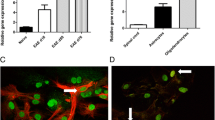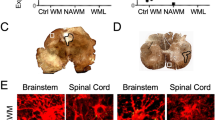Abstract
Oxidative stress is implicated in the pathogenesis of demyelinating disorders and inflammatory responses. Heme oxygenase-1 (HO-1; HSP32) is a small heat shock protein (HSP) with enzymatic activity, which is inducible by oxidative stress. In this study we analyzed autopsy and biopsy brain samples of patients with multiple sclerosis (MS) and ADEM (acute disseminated leucoencephalomylits) and spinal cord lesions of mouse EAE (experimental autoimmune encephalomyelitis), which was actively induced by immunization with myelin oligodendrocyte glycoprotein (MOG35–55) peptide, for the presence of HO-1. HO-1 was observed in glial cells during different stages: (1) during acute phases of mainly inflammatory diseases (EAE and ADEM) expression of HO-1 was prominent in microglia/macrophages and astrocytes, and upregulation correlated with inflammation, and (2) in early MS lesions HO-1 was expressed in oligodendrocytes. Furthermore, in glial cell cultures, we can show that upregulation of HO-1 in oligodendrocytes was paralleled by severe morphological damage. Oligodendrocytes underwent apoptotic cell death at a concentration of hydrogen peroxide (50–200 µM) which did not affect astrocytes or microglia. Using oligodendroglial OLN-93 cells, we demonstrate that oxidative stress led to mitochondrial impairment and the disorganization of the microtubule network. Zinc protoporphyrin, an inhibitor of HO-1, augmented the cytotoxic consequences of hydrogen peroxide in OLN-93 cells. Hence, the presence of HO-1 in EAE, ADEM, and MS points to the involvement of oxidative stress and a role of HO-1 in the pathogenesis of the diseases. The data suggest that stress-induced HO-1 initially plays a protective role, while its chronic upregulation, might contribute to oligodendroglial cell death rather than providing protection.
Similar content being viewed by others
References
Abdul-Majid, K.-B., Jirholt, J., Stadelmann, C., Stefferl, A., Kjellén, P., Wallström, E., et al. (2000). Screening of several H-2 congenic mouse strains identified H-2q mice as highly susceptible to MOG-induced EAE with minimal adjuvant requirement. Journal of Neuroimmunology, 111, 23–33.
Banati, R. B., Gehrmann, J., Schubert, P., & Kreutzberg, G. W. (1993). Cytotoxicity of microglia. Glia, 7, 111–118.
Bimbaum, G. (1995). Stress proteins: Their role in the normal central nervous system and in disease states, especially multiple sclerosis. Springer Seminars in Immunopathology, 17, 107–118.
Bourquin, C., Iglesias, A., Berger, T., Wekerle, H., & Linington, C. (2000). Myelin oligodendrocyte glycoprotein-DNA vaccination induces antibody-mediated autoaggression in experimental autoimmune encephalomyelitis. European Journal of Immunology, 30, 3663–3671.
Brosnan, C. F., Battistini, L., Gao, Y. L., & Aquino, D. A. (1996). Heat shock proteins and multiple sclerosis: A review. Journal of Neuropathology and Experimental Neurology, 55, 389–402.
Brück, W., Luccinetti, C., & Lassmann, H. (2002). The pathology of primary progressive multiple sclerosis. Multiple Sclerosis, 8, 93–97.
Chakrabarty, A., Emerson, M. R., & LeVine, S. M. (2003), Heme oxygenase-1 in SJL mice with experimental allergic encephalomyelitis. Multiple Sclerosis, 9, 372–381.
Desagher, S., & Martinou, J. C. (2000). Mitochondria as the central control point of apoptosis. Trends in Cell Biology, 10, 369–377.
Elbirt, K. K., & Bonkovsky, H. L. (1999). Heme oxygenase: Recent advances in understanding its regulation and role. Proceedings of the Association American Physicians, 111, 438–447.
Elbirt, K. K., Whitmarsh, A. J., Davis, R. J., & Bonkovsky, H. L. (1998). Mechanism of sodium arsenite-mediated induction of heme oxygenase-1 in hepatoma cells. Role of mitogen-activated protein kinases. Journal of Biological Chemistry, 372, 8922–8931.
Emerson, R. M., & LeVine, S. M. (2000). Heme oxygenase-1 and NADPH cytochrome P450 reductases expression in experimental allergic encephalomyelitis: An expanded view of the stress response. Journal of Neurochemistry, 75, 2555–2562.
Eugster, H.-P., Frei, K., Bachmann, R., Bluethmann, H., Lassmann, H., & Fontana, A. (1999). Severity of symptoms and demyelination in MOG-induced EAE depends on TNFR1. European Journal of Immunology, 29, 626–632.
Fink, A. L. (1999). Chaperone-mediated protein folding. Physiological Reviews, 79, 425–449.
Goldbaum, O., & Richter-Landsberg, C. (2001). Stress proteins in oligodendrocytes: Differential effects of heat shock and oxidative stress. Journal of Neurochemistry, 78, 1233–1242.
Goldbaum, O., & Richter-Landsberg, C. (2002). Activation of PP2A-like phosphatase and modulation of tau phosphorylation accompany stress-induced apoptosis in cultured oligodendrocytes. Glia, 40, 271–282.
Head, M. W., & Goldman, J. E. (2000). Small heat shock proteins, the cytoskeleton and inclusion body formation. Neuropathology and Applied Neurobiology, 26, 304–312.
Heneka, M. T., Sharp, A., Murphy, P., Lyons, J. A., Dumitrescu, L., & Feinstein, D. L. (2001). The heat shock response reduces myelin oligodendrocyte glycoprotein-induced experimental autoimmune encephalomyelitis in mice. Journal of Neurochemistry, 77, 568–579.
Henningsson, R., Alm, P., Ekström, P., & Lundquist, I. (1999). Heme oxygenase and carbon monoxide: Regulatory roles in islet hormone release. A biochemical, immunohistochemical, and confocal microscopic study. Diabetes, 48, 66–76.
Jelinski, S. E., Yager, J. Y., & Juurlink, B. H. J. (1999). Preferential injury of oligodendroblasts by a short hypoxic-ischemic insult. Brain Research, 815, 150–153.
Johns, T. G., Kerlero, D. R., Menon, K. K., Abo, S., Gonzales, M. F., & Bernard, C. C. (1995). Myelin oligodendrocyte glycoprotein induces a demyelinating encephalomyelits resembling multiple sclerosis. Journal of Neuroimmunology, 154, 5536–5541.
Kalman, B., & Leist, T. P. (2003). A mitochondrial component of neurodegeneration in multiple sclerosis. NeuroMolecular Medicine, 3, 147–157.
Lassmann, H., Brück, W., & Lucchinetti, C. (2001). Heterogeneity of multiple sclerosis pathogenesis: Implications for diagnosis and therapy. Trends in Molecular Medicine, 7, 115–121.
Liang, P., & MacRae, T. H. (1997). Molecular chaperones and the cytoskeleton. Journal of Cell Science, 110, 1431–1440.
Liu, Y., Tachibana, T., Dai, Y., Kondo, E., Fukuoka, T., Yamanaka, H., et al. (2002). Heme oxygenase-1 expression after spinal cord injury: The induction in activated neutrophils. Journal of Neurotrauma, 19, 479–490.
Liu, Y., Zhu, B., Luo, L., Paty, D. W., & Cynader, M. S. (2001). Heme oxygenase-1 plays an important protective role in experimental autoimmune encephalomyelitis. Neuroreport, 12, 1841–1845.
Ludwin, S. K. (1997). The pathobiology of the oligodendrocyte. Journal of Neuropathology and Experimental Neurology, 56, 111–124.
Malipiero, U., Frei, K., Spanaus, K.-S., Agresti, C., Lassmann, H., Hahne, M., et al. (1997). Myelin oligodendrocyte glycoprotein-induced autoimmune encephalomyelitis is chronic/relapsing in perforin knockout mice, but monophasic in Fas- and Fas ligand-deficient lpr and gld mice. European Journal of Immunology, 27, 3151–3160.
McMorris, F. A., Miller, S. L., Pleasure, D., & Abramsky, O. (1981). Expression of biochemical properties of oligodendrocytes in oligodendrocyte×glioma cell hybrids proliferating in vitro. Experimental Cell Research, 133, 395–404.
Mendel, I., Kerlero de Rosbo, N., & Ben-Nun, A. (1995). A myelin oligodendrocyte glycoprotein peptide induces typical chronic experimental autoimmune encephalomyelitis in H-2b mice: Fine specificity and T cell receptor Vβ expression of encephalitogenic T cells. European Journal of Immunology, 25, 1951–1959.
Minghetti, L., Polazzi, E., Nicolini, A., & Levi, G. (1998). Opposite regulation of prostaglandin E2 synthesis by transforming growth factor-beta1 and interleukin 10 in activated microglial cultures. Journal of Neuroimmunology, 82, 31–39.
Mronga, T., Stahnke, T., Goldbaum, O., & Richter-Landsberg, C. (2004). Mitochondrial pathway is involved in hydrogen peroxide induced apoptotic cell death of oligodendrocytes. Glia, 46, 446–455.
Nacken, W., Roth, J., Sorg, C., & Kerkhoff, C. (2003). S100A9/S100A8: Myeloid representatives of the S100 protein family as prominent players in innate immunity. Microscopy Research and Technique, 60, 569–580.
Neuhoff, V., Philipp, K., Zimmer, H. G., & Mesecke, S. (1979). A simple, versatile, sensitive and volume-independent method for quantitative protein determination which is independent of other external influences. Hoppe-Seyler’s Zeitschrift für Physiologische Chemie, 360, 1657–1670.
Richter-Landsberg, C. (2001). Organization and functional roles of the cytoskeleton in oligodendrocytes. Microscopy Research and Technique, 52, 628–636.
Richter-Landsberg, C., & Goldbaum, O. (2003). Stress responses in neural cells: Functional roles in health and disease. Cellular and Molecular Life Sciences, 60, 337–349.
Richter-Landsberg, C., & Heinrich, M. (1996). OLN-93: A new permanent oligodendroglia cell line derived from primary rat brain glial cultures. Journal of Neuroscience Research, 45, 161–173.
Samali, A., & Cotter, T. G. (1996). Heat shock proteins increase resistance to apoptosis. Experimental Cell Research, 223, 163–170.
Schipper, H. M. (2000). Heme oxygenase-1: Role in brain aging and neurodegeneration. Experimental Gerontology, 35, 821–830.
Schipper, H. M. (2004). Heme oxygenase-1: Transducer of pathological brain iron sequestration under oxidative stress. Annals of the New York Academy of Sciences, 1012, 84–93.
Schluesener, H. J., & Seid, K. (2000). Heme oxygenase-1 in lesions of rat experimental autoimmune encephalomyelitis and neuritis. Journal of Neuroimmunology, 110, 114–120.
Sharp, F. R., Massa, S. M., & Swanson, R. A. (1999). Heat shock protein protection. Trends in Neurosciences, 22, 97–99.
Song, W., Su, H., Song, S., Paudel, H. K., & Schipper, H. M. (2006). Over-expression of heme oxygenase-1 promotes oxidative mitochondrial damage in rat astroglia. Journal of Cellular Physiology, 206, 655–663.
Sriram, S., & Rodriguez, M. (1997). Indictment of the microglia as the villain in multiple sclerosis. Neurology, 48, 464–470.
Steinmann, L., Martin, R., Bernard, C., Conlon, P., & Oksenberg, J. R. (2002). Multiple sclerosis: Deeper understanding of its pathogenesis reveals new targets for therapy. Annual Review of Neuroscience, 25, 491–505.
Storch, M. K., Stefferl, A., Brehm, U., Weissert, R., Wallstrom, E., Kerschensteiner, M., et al. (1998). Autoimmunity to myelin oligodendrocyte glycoprotein in rats mimics the spectrum of multiple sclerosis pathology. Brain Pathology, 8, 681–695.
van Noort, J. M., Van Sechel, A. C., Bajramovic, J. J., El Quagmiri, M., Polman, C. H., Lassmann, H., et al. (1995). The small heat shock protein αB-crystallin as candidate autoantigen in multiple sclerosis. Nature, 375, 798–801.
Vollgraf, U., Wegner, M., & Richter-Landsberg, C. (1999). Activation of AP-1 and NF-kappaB transcription factors is involved in hydrogen peroxide-induced apoptotic cell death of oligodendrocytes. Journal of Neurochemistry, 73, 2501–2509.
Author information
Authors and Affiliations
Corresponding author
Rights and permissions
About this article
Cite this article
Stahnke, T., Richter-Landsberg, C., Stadelmann, C. et al. Differential upregulation of heme oxygenase-1 (HSP32) in glial cells after oxidative stress and in demyelinating disorders. J Mol Neurosci 32, 25–37 (2007). https://doi.org/10.1007/s12031-007-0005-8
Received:
Accepted:
Published:
Issue Date:
DOI: https://doi.org/10.1007/s12031-007-0005-8




